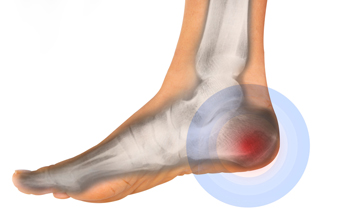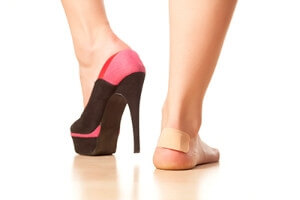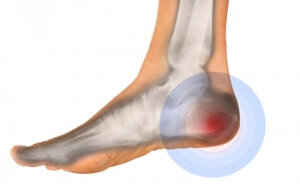Super User
Corns Can Develop on Multiple Parts of the Foot
 If you notice a bump on the side of your pinky toe, you may have developed a corn. It may come from wearing shoes that do not fit correctly and may rub against that part of the foot. Additionally, corns may appear on other areas of the foot, including the sole. A soft corn may develop in between the toes, and this may be a result of the toes constantly rubbing together. Some patients may feel corns beginning to form if they stand or walk for extended periods of time. Preventing corns may be easily achieved, and this may be accomplished by wearing shoes that fit correctly. An important consideration is to make sure there is adequate room for the toes to move about in. If you have a corn, it is suggested to speak to a podiatrist who can properly treat this condition.
If you notice a bump on the side of your pinky toe, you may have developed a corn. It may come from wearing shoes that do not fit correctly and may rub against that part of the foot. Additionally, corns may appear on other areas of the foot, including the sole. A soft corn may develop in between the toes, and this may be a result of the toes constantly rubbing together. Some patients may feel corns beginning to form if they stand or walk for extended periods of time. Preventing corns may be easily achieved, and this may be accomplished by wearing shoes that fit correctly. An important consideration is to make sure there is adequate room for the toes to move about in. If you have a corn, it is suggested to speak to a podiatrist who can properly treat this condition.
If you have any concerns regarding your feet and ankles, contact Dr. Thomas Madden of Advanced Foot Care Center. Our doctor will treat your foot and ankle needs.
Corns: What Are They? and How Do You Get Rid of Them?
Corns can be described as areas of the skin that have thickened to the point of becoming painful or irritating. They are often layers and layers of the skin that have become dry and rough, and are normally smaller than calluses.
Ways to Prevent Corns
There are many ways to get rid of painful corns such as wearing:
- Well-fitting socks
- Comfortable shoes that are not tight around your foot
- Shoes that offer support
Treating Corns
Treatment of corns involves removing the dead skin that has built up in the specific area of the foot. Consult with Our doctor to determine the best treatment option for your case of corns.
If you have any questions please feel free to contact our office located in Killeen, TX . We offer the newest diagnostic and treatment technologies for all your foot and ankle needs.
Foot Conditions May Come from Wearing High Heels
 Research has indicated that foot pain women may experience may come from from wearing high heels. The balance in the body may be altered as a result of the ankles bending forward, and this is a feeling that is similar to standing on tiptoes. Additionally, the calf muscles may be shortened which may affect the Achilles tendon, and this may lead to painful injuries. It may be helpful to limit wearing high heels, or to choose a lower and wider heel. Stretching and resting the feet frequently throughout the day may be beneficial in preventing unwanted foot conditions that may be associated with wearing this type of shoe. If you would like additional information about the possible hazards associated with wearing high heels, it is suggested to consult with a podiatrist who can properly assist you.
Research has indicated that foot pain women may experience may come from from wearing high heels. The balance in the body may be altered as a result of the ankles bending forward, and this is a feeling that is similar to standing on tiptoes. Additionally, the calf muscles may be shortened which may affect the Achilles tendon, and this may lead to painful injuries. It may be helpful to limit wearing high heels, or to choose a lower and wider heel. Stretching and resting the feet frequently throughout the day may be beneficial in preventing unwanted foot conditions that may be associated with wearing this type of shoe. If you would like additional information about the possible hazards associated with wearing high heels, it is suggested to consult with a podiatrist who can properly assist you.
High heels have a history of causing foot and ankle problems. If you have any concerns about your feet or ankles, contact Dr. Thomas Madden from Advanced Foot Care Center. Our doctor can provide the care you need to keep you pain-free and on your feet.
Effects of High Heels on the Feet
High heels are popular shoes among women because of their many styles and societal appeal. Despite this, high heels can still cause many health problems if worn too frequently.
Which Parts of My Body Will Be Affected by High Heels?
- Ankle Joints
- Achilles Tendon – May shorten and stiffen with prolonged wear
- Balls of the Feet
- Knees – Heels cause the knees to bend constantly, creating stress on them
- Back – They decrease the spine’s ability to absorb shock, which may lead to back pain. The vertebrae of the lower back may compress.
What Kinds of Foot Problems Can Develop from Wearing High Heels?
- Corns
- Calluses
- Hammertoe
- Bunions
- Morton’s Neuroma
- Plantar Fasciitis
How Can I Still Wear High Heels and Maintain Foot Health?
If you want to wear high heeled shoes, make sure that you are not wearing them every day, as this will help prevent long term physical problems. Try wearing thicker heels as opposed to stilettos to distribute weight more evenly across the feet. Always make sure you are wearing the proper shoes for the right occasion, such as sneakers for exercising. If you walk to work, try carrying your heels with you and changing into them once you arrive at work. Adding inserts to your heels can help cushion your feet and absorb shock. Full foot inserts or metatarsal pads are available.
If you have any questions please feel free to contact our office located in Killeen, TX . We offer the newest diagnostic and treatment technologies for all your foot and ankle needs.
Read more about Effect of High Heels on the FeetProper Foot Care Is Essential in Diabetic Patients
 If you are a diabetic patient, it is important to know how to properly care for your feet. It is important to notice if there are any cuts or scrapes, and this may be beneficial in avoiding infections. Many diabetic patients suffer from neuropathy, and this is the inability to feel any sores that may be present on the feet. There are measures that can be implemented to care for diabetic feet, and these may include washing and drying the feet daily, especially between the toes. Additionally, it may be helpful to avoid going barefoot, and to refrain from cutting the toenails. This is typically done by a podiatrist, who is practiced in trimming the toenails correctly. Additionally, wearing shoes that fit properly and wearing socks that are not too tight may be beneficial in helping to care for diabetic feet. If you are diabetic, it is advised that you speak to a podiatrist as quickly as possible who can guide you in how to properly take care of your feet.
If you are a diabetic patient, it is important to know how to properly care for your feet. It is important to notice if there are any cuts or scrapes, and this may be beneficial in avoiding infections. Many diabetic patients suffer from neuropathy, and this is the inability to feel any sores that may be present on the feet. There are measures that can be implemented to care for diabetic feet, and these may include washing and drying the feet daily, especially between the toes. Additionally, it may be helpful to avoid going barefoot, and to refrain from cutting the toenails. This is typically done by a podiatrist, who is practiced in trimming the toenails correctly. Additionally, wearing shoes that fit properly and wearing socks that are not too tight may be beneficial in helping to care for diabetic feet. If you are diabetic, it is advised that you speak to a podiatrist as quickly as possible who can guide you in how to properly take care of your feet.
Diabetic foot care is important in preventing foot ailments such as ulcers. If you are suffering from diabetes or have any other concerns about your feet, contact Dr. Thomas Madden from Advanced Foot Care Center. Our doctor can provide the care you need to keep you pain-free and on your feet.
Diabetic Foot Care
Diabetes affects millions of people every year. The condition can damage blood vessels in many parts of the body, especially the feet. Because of this, taking care of your feet is essential if you have diabetes, and having a podiatrist help monitor your foot health is highly recommended.
The Importance of Caring for Your Feet
- Routinely inspect your feet for bruises or sores.
- Wear socks that fit your feet comfortably.
- Wear comfortable shoes that provide adequate support.
Patients with diabetes should have their doctor monitor their blood levels, as blood sugar levels play such a huge role in diabetic care. Monitoring these levels on a regular basis is highly advised.
It is always best to inform your healthcare professional of any concerns you may have regarding your feet, especially for diabetic patients. Early treatment and routine foot examinations are keys to maintaining proper health, especially because severe complications can arise if proper treatment is not applied.
If you have any questions please feel free to contact our office located in Killeen, TX . We offer the newest diagnostic and treatment technologies for all your foot and ankle needs.
Read more about Diabetic Foot ConditionsMany Types of Foot Surgery
 Many patients have had their various foot conditions successfully treated, but for some, foot surgery may be necessary as a possible option for relief. There are several types of foot issues that can benefit from having foot surgery performed, and these may include bunions, hammertoes, and arthritis. The surgery that may help to correct bunions is referred to as a bunionectomy. The benefits of having this type of surgery performed may include wearing shoes that are closed, and performing daily activities with ease. Arthritis may be helped by having fusion surgery performed, and this may help to join the bones of the foot together which may eliminate painful rubbing. Hammertoe can be helped by removing bones, tendons, or joints which may help to straighten out the toe. If the plantar fascia is inflamed which may lead to plantar fasciitis, heel surgery may be a viable option to consider. If you would like additional information about foot surgery, please consult with a podiatrist who can answer any questions you may have.
Many patients have had their various foot conditions successfully treated, but for some, foot surgery may be necessary as a possible option for relief. There are several types of foot issues that can benefit from having foot surgery performed, and these may include bunions, hammertoes, and arthritis. The surgery that may help to correct bunions is referred to as a bunionectomy. The benefits of having this type of surgery performed may include wearing shoes that are closed, and performing daily activities with ease. Arthritis may be helped by having fusion surgery performed, and this may help to join the bones of the foot together which may eliminate painful rubbing. Hammertoe can be helped by removing bones, tendons, or joints which may help to straighten out the toe. If the plantar fascia is inflamed which may lead to plantar fasciitis, heel surgery may be a viable option to consider. If you would like additional information about foot surgery, please consult with a podiatrist who can answer any questions you may have.
Foot surgery is sometimes necessary to treat a foot ailment. To learn more, contact Dr. Thomas Madden of Advanced Foot Care Center. Our doctor will assist you with all of your foot and ankle needs.
When Is Surgery Necessary?
Foot and ankle surgery is generally reserved for cases in which less invasive, conservative procedures have failed to alleviate the problem. Some of the cases in which surgery may be necessary include:
- Removing foot deformities like bunions and bone spurs
- Severe arthritis that has caused bone issues
- Cosmetic reconstruction
What Types of Surgery Are There?
The type of surgery you receive will depend on the nature of the problem you have. Some of the possible surgeries include:
- Bunionectomy for painful bunions
- Surgical fusion for realignment of bones
- Neuropathy decompression surgery to treat nerve damage
Benefits of Surgery
Although surgery is usually a last resort, it can provide more complete pain relief compared to non-surgical methods and may allow you to finally resume full activity.
Surgical techniques have also become increasingly sophisticated. Techniques like endoscopic surgery allow for smaller incisions and faster recovery times.
If you have any questions please feel free to contact our office located in Killeen, TX . We offer the newest diagnostic and treatment technologies for all your foot and ankle needs.
Read more about Foot SurgeryFoot Surgery
In most cases, foot surgery is often chosen as the last available option for conditions that have otherwise been unsuccessfully treated. Surgery may be necessary for several reasons, including the removal of foot deformities (e.g. bone spurs or bunions), arthritis problems, reconstruction due to injury, and congenital malformations (e.g. club foot or flat feet). Regardless of one’s age, foot surgery may be the only successful option for treatment for certain conditions.
The type of surgery one undergoes depends on the type of foot condition the patient has. For the removal of a bunion growth, a bunionectomy is necessary. If the bones in the feet need to be realigned or fused together, a surgical fusion of the foot is needed. For pain or nerve issues, a patient may require surgery in which the tissues surrounding the painful nerve are removed. Initially, less invasive treatments are generally attempted; surgery is often the last measure taken if other treatments are unsuccessful.
While in many cases surgery is often deemed as the final resort, choosing surgery comes with certain benefits. The associated pain experienced in relation to the particular condition is often relieved with surgery, allowing patients to quickly resume daily activities. The greatest benefit, however, is that surgery generally eliminates the problem immediately.
Podiatry history has shown that foot treatments continue to evolve over time. In the field of foot surgery, endoscopic surgery is just one of the many advanced forms of surgery. As technology vastly improves so too will the various techniques in foot surgery, which already require smaller and smaller incisions with the use of better and more efficient tools. Thanks to such innovations, surgery is no longer as invasive as it was in the past, allowing for faster and easier recoveries.
Causes of Heel Pain
 Many patients suffer from heel pain, and there may be several reasons why this may occur. These may include injuries to the foot that involves the heel, chronic conditions such as plantar fasciitis, bruises or stress fractures. Achilles tendonitis may develop as result of overuse, which may happen while participating in sporting activities. A heel pad bruise may occur as a result of wearing shoes that do not have adequate cushioning. It may also occur from falling from a high distance and landing on the heel. A condition that is known as haglund’s syndrome may occur if a bony protrusion develops on the back of the heel as it rubs against shoes that are stiff. Symptoms of this may include pain in the heel area of the foot, and possible swelling. If you are experiencing any type of heel pain, it is strongly suggested that you seek the counsel of a podiatrist who can properly diagnose and treat heel pain.
Many patients suffer from heel pain, and there may be several reasons why this may occur. These may include injuries to the foot that involves the heel, chronic conditions such as plantar fasciitis, bruises or stress fractures. Achilles tendonitis may develop as result of overuse, which may happen while participating in sporting activities. A heel pad bruise may occur as a result of wearing shoes that do not have adequate cushioning. It may also occur from falling from a high distance and landing on the heel. A condition that is known as haglund’s syndrome may occur if a bony protrusion develops on the back of the heel as it rubs against shoes that are stiff. Symptoms of this may include pain in the heel area of the foot, and possible swelling. If you are experiencing any type of heel pain, it is strongly suggested that you seek the counsel of a podiatrist who can properly diagnose and treat heel pain.
Many people suffer from bouts of heel pain. For more information, contact Dr. Thomas Madden of Advanced Foot Care Center. Our doctor can provide the care you need to keep you pain-free and on your feet.
Causes of Heel Pain
Heel pain is often associated with plantar fasciitis. The plantar fascia is a band of tissues that extends along the bottom of the foot. A rip or tear in this ligament can cause inflammation of the tissue.
Achilles tendonitis is another cause of heel pain. Inflammation of the Achilles tendon will cause pain from fractures and muscle tearing. Lack of flexibility is also another symptom.
Heel spurs are another cause of pain. When the tissues of the plantar fascia undergo a great deal of stress, it can lead to ligament separation from the heel bone, causing heel spurs.
Why Might Heel Pain Occur?
- Wearing ill-fitting shoes
- Wearing non-supportive shoes
- Weight change
- Excessive running
Treatments
Heel pain should be treated as soon as possible for immediate results. Keeping your feet in a stress-free environment will help. If you suffer from Achilles tendonitis or plantar fasciitis, applying ice will reduce the swelling. Stretching before an exercise like running will help the muscles. Using all these tips will help make heel pain a condition of the past.
If you have any questions please contact our office located in Killeen, TX . We offer the newest diagnostic and treatment technologies for all your foot and ankle needs.
Read more about Heel Pain








